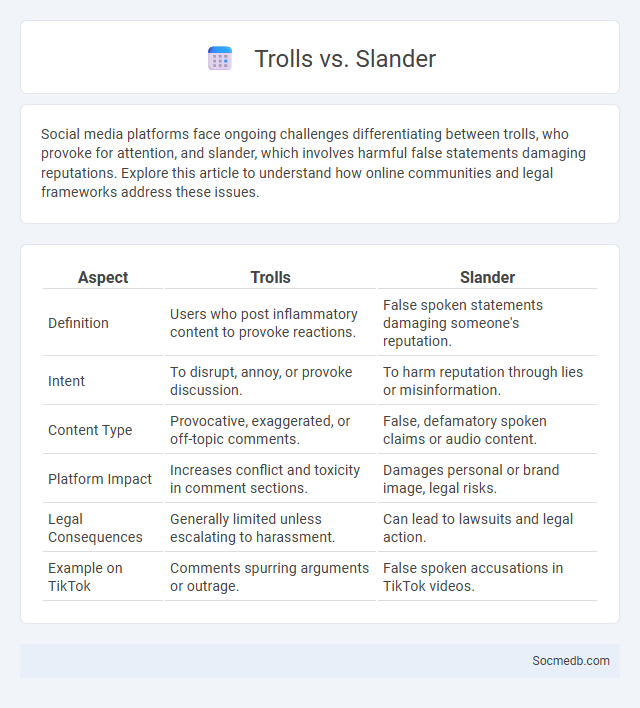
Photo illustration: Trolls vs Slander
Social media platforms face ongoing challenges differentiating between trolls, who provoke for attention, and slander, which involves harmful false statements damaging reputations. Explore this article to understand how online communities and legal frameworks address these issues.
Table of Comparison
| Aspect | Trolls | Slander |
|---|---|---|
| Definition | Users who post inflammatory content to provoke reactions. | False spoken statements damaging someone's reputation. |
| Intent | To disrupt, annoy, or provoke discussion. | To harm reputation through lies or misinformation. |
| Content Type | Provocative, exaggerated, or off-topic comments. | False, defamatory spoken claims or audio content. |
| Platform Impact | Increases conflict and toxicity in comment sections. | Damages personal or brand image, legal risks. |
| Legal Consequences | Generally limited unless escalating to harassment. | Can lead to lawsuits and legal action. |
| Example on TikTok | Comments spurring arguments or outrage. | False spoken accusations in TikTok videos. |
Understanding Trolls: Definition and Characteristics
Trolls are individuals who deliberately provoke and disrupt online communities by posting inflammatory, off-topic, or offensive messages to elicit emotional responses. These users often exploit anonymity and manipulate social dynamics to create conflict and derail constructive conversations. Recognizing troll behavior involves identifying patterns of repeated provocation, disregard for community norms, and attempts to undermine discussion without contributing meaningful content.
What Constitutes Slander? Legal and Social Context
Slander constitutes false spoken statements that damage a person's reputation, requiring proof of harm and intent in legal contexts. Social media amplifies the impact of slander by rapidly spreading defamatory remarks to wide audiences, intensifying reputational harm. Understanding how your words may be perceived and legally interpreted on digital platforms is crucial to avoid slander accusations and protect your online presence.
Trolls vs Slander: Key Differences Explained
Trolls provoke and disrupt conversations on social media platforms by posting inflammatory or off-topic messages, aiming to elicit emotional responses or chaos. Slander involves making false, damaging statements about someone, which can harm their reputation and may lead to legal consequences. Understanding the key differences helps protect your online presence by identifying whether a harmful encounter is intended as provocation or defamation.
Motivations Behind Online Trolling
Online trolling is often driven by a desire for attention, personal amusement, or the need to provoke emotional reactions from others. Some users engage in trolling to assert dominance, express frustration, or challenge social norms anonymously. Psychological factors such as low empathy and a propensity for aggressive behavior also contribute significantly to the motivations behind online trolling.
Recognizing Slander in Digital Platforms
Recognizing slander on digital platforms requires understanding false statements that harm your reputation or credibility. Social media algorithms can amplify slander quickly, making it crucial to identify defamatory comments and distinguish them from criticism or opinions. Protecting yourself involves documenting evidence and using platform tools to report or block damaging content effectively.
Overlapping Behaviors: When Trolls Become Slanderous
Online trolls often engage in overlapping behaviors that escalate from harmless pranks to harmful slander, blurring the lines between free expression and defamation. Understanding the patterns of these behaviors helps in identifying coordinated attacks designed to damage reputations through false or malicious statements. Protecting your digital presence requires vigilance against these intertwined tactics to maintain a safe and respectful social media environment.
Legal Consequences: Trolling vs Slander
Trolling on social media can lead to account suspension and potential civil lawsuits if the behavior crosses into harassment or defamation. Slander involves making false spoken statements damaging to a person's reputation and may result in legal action, including fines or damages awarded in court. Understanding the distinction between trolling as provocative speech and slander as defamatory speech is crucial for navigating the legal consequences of online conduct.
Managing Trolls and Handling Slander
Effective social media management requires proactive strategies to identify and mitigate troll behavior, including monitoring comments, setting clear community guidelines, and employing moderation tools to prevent disruptive content. Handling slander involves timely fact-checking, issuing public clarifications or corrections, and utilizing legal measures when defamatory statements harm reputation. Leveraging AI-driven sentiment analysis enhances early detection of negative content, enabling swift response to protect brand integrity and foster a positive online environment.
Protecting Yourself from Online Harassment
Protecting yourself from online harassment requires strong privacy settings and careful control over the personal information you share across social media platforms like Facebook, Instagram, and Twitter. Utilize blocking and reporting tools to immediately address any abusive behavior and consider enabling two-factor authentication to safeguard your accounts from unauthorized access. You can also benefit from regularly reviewing your follower lists and engaging only with trusted connections to maintain a safe online environment.
The Future of Digital Communication: Combating Trolls and Slander
The future of digital communication hinges on advanced AI algorithms designed to detect and combat trolls and slander, enhancing online safety and user experience. Social media platforms are investing heavily in real-time moderation tools that analyze context and sentiment to prevent harmful content from spreading. Protecting your digital interactions ensures a more respectful and trustworthy online environment.
 socmedb.com
socmedb.com